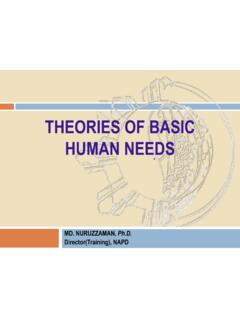Transcription of The Need to Belong: Desire for Interpersonal Attachments ...
1 Psychological Bulletin1995, Vol. 117, No. 3, 497-529 Copyright 1995 by the American Psychological Association, Need to belong : Desire for Interpersonal Attachments as aFundamental Human MotivationRoy F. BaumeisterCase Western Reserve UniversityMark R. LearyWake Forest UniversityA hypothesized need to form and maintain strong, stable Interpersonal relationships is evaluated inlight of the empirical literature. The need is for frequent, nonaversive interactions within an ongoingrelational bond. Consistent with the belongingness hypothesis, people form social attachmentsreadily under most conditions and resist the dissolution of existing bonds.
2 Belongingness appears tohave multiple and strong effects on emotional patterns and on cognitive processes. Lack of attach-ments is linked to a variety of ill effects on health, adjustment, and well-being. Other evidence, suchas that concerning satiation, substitution, and behavioral consequences, is likewise consistent withthe hypothesized motivation. Several seeming counterexamples turned out not to disconfirm thehypothesis. Existing evidence supports the hypothesis that the need to belong is a powerful, funda-mental, and extremely pervasive purpose of this review is to develop and evaluate the hy-pothesis that a need to belong is a fundamental human motiva-tion and to propose that the need to belong can provide a pointof departure for understanding and integrating a great deal ofthe existing literature regarding human Interpersonal precisely.
3 The belongingness hypothesis is that human be-ings have a pervasive drive to form and maintain at least a min-imum quantity of lasting, positive, and significant interpersonalrelationships. Satisfying this drive involves two criteria: First,there is a need for frequent, affectively pleasant interactionswith a few other people, and, second, these interactions musttake place in the context of a temporally stable and enduringframework of affective concern for each other's welfare. Interac-tions with a constantly changing sequence of partners will beless satisfactory than repeated interactions with the sameperson (s), and relatedness without frequent contact will also beunsatisfactory.
4 A lack of belongingness should constitute severedeprivation and cause a variety of ill effects. Furthermore, agreat deal of human behavior, emotion, and thought is causedby this fundamental Interpersonal hypothesis that people are motivated to form and maintaininterpersonal bonds is not new, of course. John Donne (1975) hasbeen widely quoted for the line "No [person] is an island." In psy-chology, the need for Interpersonal contact was asserted in severalways by Freud ( , 1930), although he tended to see the motiveas derived from the sex drive and from the filial bond.
5 MaslowRoy F. Baumeister, Department of Psychology, Case Western ReserveUniversity; Mark R. Leary, Department of Psychology, Wake thank Bob Hogan, Ned Jones, Richard Moreland, Dave Myers,Len Newman, Paula Pietromonaco, Harry Reis, Dan Wegner, and Di-anne Tice for comments on preliminary concerning this article should be addressed to RoyF. Baumeister, Department of Psychology, Case Western Reserve Uni-versity, 10900 Euclid Avenue, Cleveland, Ohio 44106-7123. Electronicmail may be sent via Internet to ranked "love and belongingness needs " in the middle of hismotivational hierarchy; that is, belongingness needs do not emergeuntil food, hunger, safety, and other basic needs are satisfied, butthey take precedence over esteem and self-actualization.
6 Bowlby's( , 1969,1973) attachment theory also posited the need to formand maintain relationships. His early thinking followed the Freud-ian pattern of deriving attachment needs from the relationship toone's mother; he regarded the adult's need for attachment as aneffort to recapture the intimate contact that the individual had, asan infant, with his or her Horney (1945), Sullivan(1953), Fromm (1955, 1956), de Rivera(1984), Hogan (1983),Epstein (1992), Ryan (1991), Guisinger and Blatt (1994), andothers have made similar suggestions.
7 The existence of a need tobelong is thus a familiar point of theory and speculation, althoughnot all theorists have anticipated our particular formulation of thisneed as the combination of frequent interaction plus persistentcaring. Moreover, most theorists have neglected to provide system-atic empirical evaluation of this hypothesis. For example, Mas-low's (1968) influential assertion of a belongingness need was ac-companied by neither original data nor review of previous find-ings. Thus, despite frequent, speculative assertions that peopleneed to belong , the belongingness hypothesis needs to be criticallyevaluated in light of empirical evidence.
8 A main goal of the presentarticle is to assemble a large body of empirical findings pertinentto the belongingness hypothesis to evaluate how well the hypothe-sis fits the goal of this article is to demonstrate the broad appli-cability of the need to belong for understanding human motiva-tion and behavior. Even though many psychological theoristshave noted human affiliative tendencies in one form or another,the field as a whole has neglected the broad applicability of this1 His later thinking may, however, have moved beyond this view toregard attachment needs as having a separate, even innate basis ratherthan being derived from the contact with one's mother; in this laterview, he treated the relationship to one's mother as simply an influentialprototype of F.
9 BAUMEISTER AND MARK R. LEARY need to a wide range of behaviors. Thus, for example, the mo-tive literature has been dominated by research on the respectiveneeds for power, achievement, intimacy, approval, and, to alesser extent, affiliation. But the need for power may well bedriven by the need to belong , as we suggest later. Likewise, peo-ple prefer achievements that are validated, recognized, and val-ued by other people over solitary achievements, so there maybe a substantial Interpersonal component behind the need forachievement.
10 And the needs for approval and intimacy are un-doubtedly linked to the fact that approval is a prerequisite forforming and maintaining social bonds, and intimacy is a denn-ing characteristic of close relationships. The need to belongcould thus be linked to all of , even a quick glance at research on social be-havior from the perspective of the belongingness hypothesisraises the possibility that much of what human beings do is donein the service of belongingness. Thus, the belongingness hypoth-esis might have considerable value for personality and socialpsychology and even for psychology as a whole.















